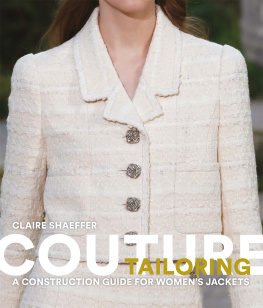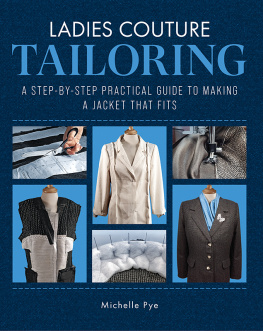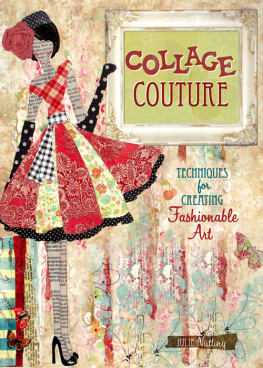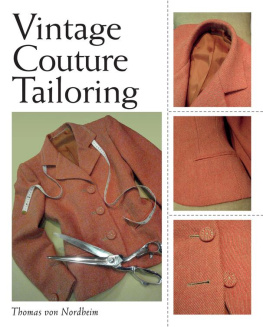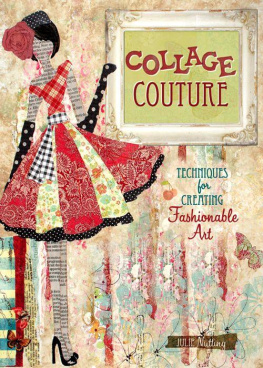Contents
Guide
COUTURE
TAILORING

Published in Great Britain by
Laurence King Student & Professional
An imprint of Quercus Editions Ltd
Carmelite House
50 Victoria Embankment
London EC4Y 0DZ
An Hachette UK company
Text 2021 Claire B. Shaeffer
The moral right of Claire B. Shaeffer to be identified as the author of this work has been asserted in accordance with the Copyright, Designs and Patents Act, 1988.
All rights reserved. No part of this publication may be reproduced or transmitted in any form or by any means, electronic or mechanical, including photocopy, recording, or any information storage and retrieval system, without permission in writing from the publisher.
A CIP catalogue record for this book is available from the British Library.
ISBN: 978-1-52942-091-3
Illustrations by Thom Olson
Commissioned photography by Bill Marchese
Design by The Urban Ant Ltd
Picture research by Giulia Hetherington
Front cover photograph: Franois Mori/AP/Shutterstock
COUTURE
TAILORING
A Construction Guide
for Womens Jackets
CLAIRE SHAEFFER
LAURENCE KING PUBLISHING
An imprint of Quercus Editions Ltd
www.laurenceking.com/student/
CONTENTS
PART ONE
Tailoring Basics: Equipment, Fabrics, and Essential Skills
PART TWO
Construction Guide to Tailoring a Couture Jacket
INTRODUCTION
Couture Tailoring is a comprehensive guide to tailoring a womans haute couture jacket using classic couture techniques. The jacket can be a traditional tailored design inspired by menswear, with a notch collar and two-piece set-in sleeves, or it can be a more feminine design with a variety of collar and sleeve choices. Many of the techniques described in this book can be used for tailoring a mans jacket as well as for creating any luxury garment for women and children; in addition, some can be adapted for everyday sewing.
The emphasis in this book is on hand tailoring a womans jacket, and the techniques are described as they are used in couture ateliers, where designs are made with an extraordinary attention to detail using time-consuming, hand-executed techniques. There is such a preponderance of hand sewing that a couture design is often described as made by hand. Made by hand describes shaping techniques such as pad stitching, shrinking and stretching, molding the fabrics and canvas, and pressing. These techniques are used not only during the jackets assembly but also on individual garment sections before they are sewn together. Basting (tacking) stitches are frequently used to control the materials, only to be removed a short time later. Machine stitching is used primarily on the vertical seams of the jacket body and sleeves; lining seams can be machine stitched or hand sewn. Both the individual construction methods and the construction sequence are different from those used in home sewing and in ready-to-wear production. A quick look at the couture process will help you understand some of its uniqueness.

This handmade shoulder pad is from a 1960s Yves Saint Laurent design. Two layers of hair canvas are machine quilted for the top layer. The cotton wadding layers are hand sewn to the canvas.
An haute couture garmentin this instance a jacketbegins with a toile. The toile is a prototype made by draping pieces of muslin (also known as calico) on a dress form that has been padded to duplicate the customers figure. At Valentino, standard-size dress forms are fitted with zip-on covers that have been padded to duplicate the figures of each client. The toile for your jacket can begin with a purchased pattern or an original design that you have draped or drafted using the flat pattern method.
In the atelier, the toile is developed by the premir (e), the seconde, or premire main. During the draping process, adjustments are made for the clients size and proportions so it will fit and flatter, even though she may have a less than perfect or an asymmetrical figure. The toile is rarely fitted on the client.
After the toile is fitted on the dress form, a clean muslin pattern is made. Then all seams and hems are marked with thread tracings on the fabric. Generous seam and hem allowances are left when the pieces are cut in case they need to be adjusted. It is not uncommon for the seam allowances to be uneven in width since the thread-traced seam lines will be matched during construction, instead of the cut edges, as happens in home sewing and manufacturing.
The jacket is completely basted so the fit can be fine-tuned for the clients figure. After the fitting, the jacket is returned to the atelier, ripped apart, and laid flat (mis a plat). If the design is complex or the figure is difficult to fit, there will be additional fittings and, when necessary, new garment sections will be cut. After corrections and changes are made, any embroidery or beading will be completed, fabric and interfacings shaped, pockets set permanently, fronts pad stitched, and the revers shaped. Any seams that dont require additional fitting are basted again and machine stitched. After the fit of the jacket body is established, the collar and sleeves are fitted and the lining is added.
In bespoke tailoring, the focus is primarily on menswear and the early stages of the process are slightly different. The customer is measured and the measurements are used by the cutter to draft the pattern. The jacket is made up by a tailor using traditional tailoring techniques similar to those used for womens designs. In some workrooms, the undercollar is pad stitched by a specialist, the linings are felled by a finisher, and thread buttonholes are made by an expert.
This book begins with an Illustrated Survey, which is divided into two groups: hard-tailored designs inspired by a mans lounge or sack coat, and more softly tailored feminine designs. As you peruse the Illustrated Survey, youll find a variety of silhouettes, neckline designs, collars, pockets, sleeves, and closures, as well as interesting plaid and fabric combinations to provide inspiration for your jacket designs.
Part One provides a guide for choosing appropriate equipment, supplies, and fabrics. It includes easy-to-follow instructions for the basic couture techniques. These essential skills include hand sewing, cutting and marking, pressing, seams and hems, pockets, and buttonholes indispensable skills that you will use again and again, not only for tailored jackets, but for any luxury design.
Part Two describes a logical sequence for making a couture jacket, from the cutting and marking to the final press and attaching a label. Construction details include making and fitting a toile, cutting and shaping the canvas, assembling the entoilage, pad stitching and taping the fronts, shaping the lapels and collars, hand and machine methods for the collar, shaping and setting sleeves, and hand-sewn linings.
Throughout the book, you will find many little-known professional techniques and couture hints for successful results that you will be able to incorporate into all of your sewing.
Welcome to the world of haute couture.

Shalom Harlow in Yves Saint Laurent, Fall/Winter 20012002

